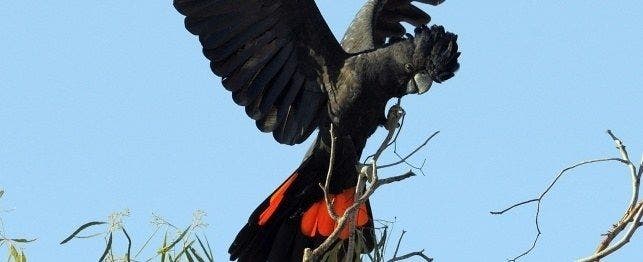
Choosing a Red-Tailed Black Cockatoo
The red-tailed black cockatoo is a unique and magnificent species. Common in north and central Australia, the red-tailed black cockatoo inhabits eucalyptus forests especially along rivers. They are very nomadic and move about in search of food in flocks of up to 2000 birds. They feed primarily in trees on Eucalyptus and Casuarina as well as other species.
Red-tailed black cockatoos are lean lanky birds. They are relatively quiet. Their rarity outside of Australia makes it unlikely they will be available for pets. Very few birds are in captivity except in zoos and specialized private collections.
Red-tailed black cockatoos (Calyptorhynchus banksii) and other cockatoo species can be very long lived (probably around 50 years) but precise life span is unknown.
Appearance and Personality
Red-tailed black cockatoos are large black cockatoos with recumbent crests. They are dimorphic by plumage color. The male is solid black except for broad red panels on the lateral tail feathers. The central tail feathers are totally black. The female’s undersides are barred with red/orange scallops on the coverts. The back and upper wings are speckled. The tail has patches of yellow-orange with black bars.
Red-tailed black cockatoos are inquisitive and love to chew objects in their surroundings. Their beak was designed for chewing trees and they are very powerful chewers. They are very destructive if allowed to perch on furniture. The red-tailed black cockatoo should always be provided with toys, blocks of wood or branches that they can chew.
Feeding
Red-tailed black cockatoos are efficient in utilization of calories as the white and pink cockatoos although they are not likely to become obese. Red-tailed black cockatoos should be fed a formulated (pelleted or extruded) diet as a basis for good nutrition. The diet should be supplemented with fresh fruits and vegetables daily to add variety and psychological enrichment. Feed approximately 1/3 cup of a formulated diet and 1/3 cup of fresh fruits and vegetables daily. They should also be offered 2 to 3 large nuts daily. The best choices are walnuts, pecans, macadamia nuts, almonds or filberts. If peanuts are fed they should be shelled first and inspected for fungal growth. Red-tailed black cockatoos are usually lean by nature and not likely to become overweight. Vitamin supplements are not needed for birds that are eating a formulated diet. Provide fresh branches for additional chewing.
Housing
One inch by one inch by 12 gauge welded wire is a good choice for cage construction. For birds that are destructive of wire, chain link is the most durable caging material. A full flight, to the ground, is recommended. A suggested size is 5 feet wide by 8 feet tall by 12 feet long.
Breeding
Red-tailed black cockatoos are difficult to breed in captivity. They require a roomy flight with privacy. Clutch size is typically 1 to 2 eggs.
The nest box should be open on top, 24 inches by 24 inches by 48 inches vertical. The act of chewing a wooden nest box may stimulate reproductive behavior. They should be provided with branches that they might use to line their nest.
Incubation period is approximately 27 to 30 days. Chicks will usually fledge at approximately 10 to 12 weeks of age. Red-tailed black cockatoos can be difficult to hand-rear and should only be attempted by very experienced hand-feeders. Ideally, chicks should be parent reared to avoid imprinting.
Male cockatoos frequently become aggressive toward their mates. While such attacks have occurred with red-tailed black cockatoos this behavior is uncommon. Because of large flights needed for this species, the male should not be clipped as in other cockatoo species.
When breeding cockatoos, noise and proximity to neighbors must be considered. If housed outdoors cockatoos often call at night especially during a full moon. In southern states outdoor caging must be protected from opossums to prevent exposure to the parasite Sarcocystis falcatula which can result in a fatal lung infection.